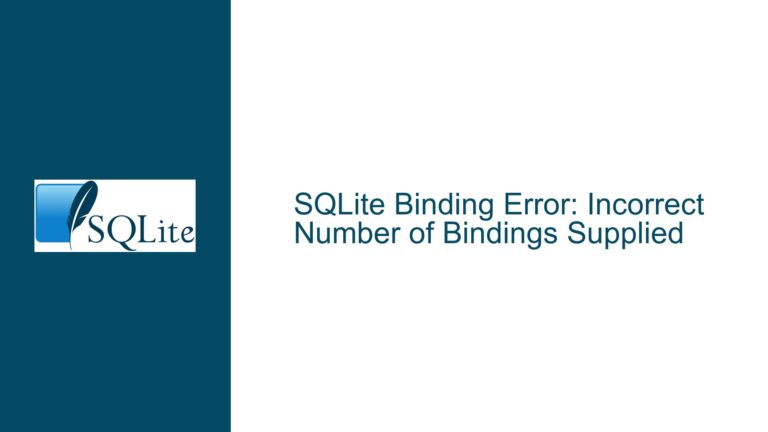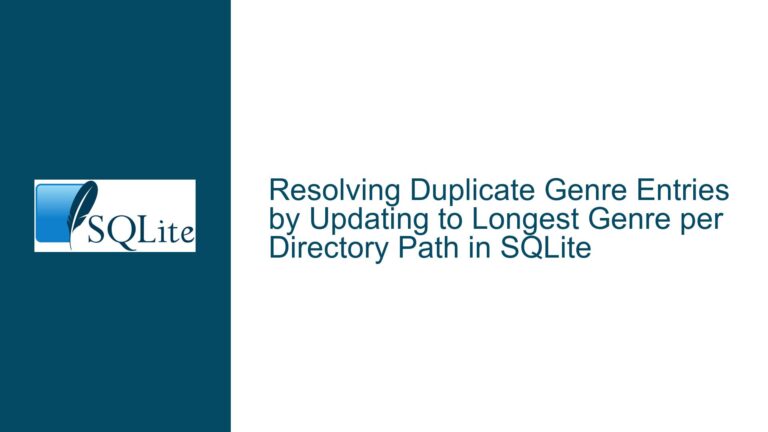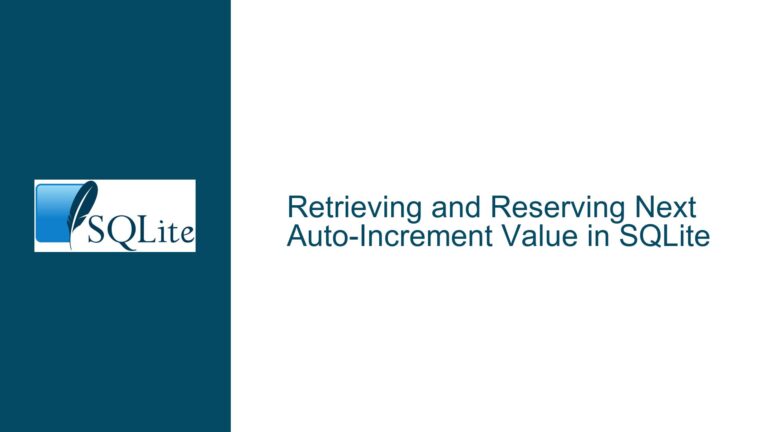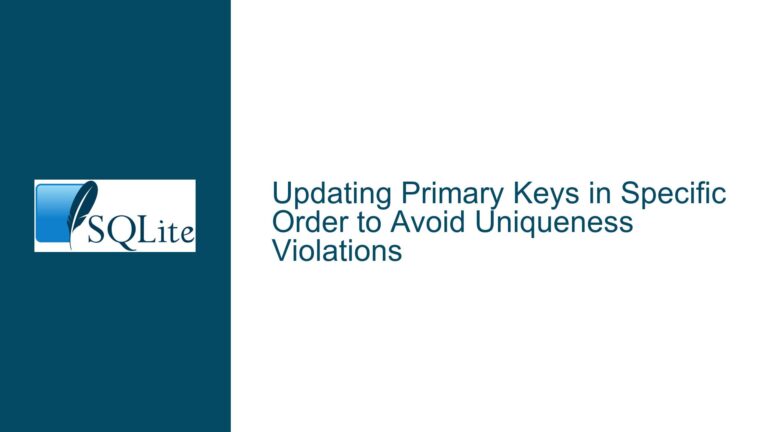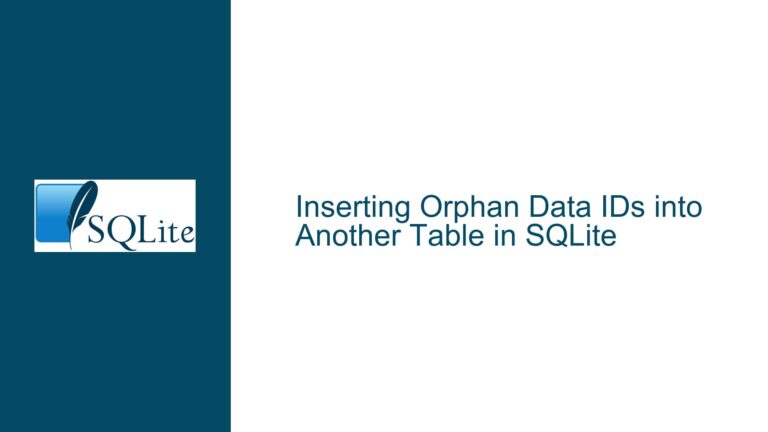SQLite CSV Import Issue: Pipe Separator and Header Parsing
Issue Overview: Pipe Separator and Header Parsing in SQLite CSV Import
When working with SQLite, one of the most common tasks is importing data from CSV files. The .import command is a powerful tool for this purpose, but it can be tricky to configure correctly, especially when dealing with non-standard separators and headers. The core issue here revolves around the use of the pipe (|) character as a separator and the failure of SQLite to recognize the first line of the CSV file as a header.
The user attempted to import a CSV file named my_file_csv using the following commands:
.mode csv
.separator |
.import reports/my_file_csv
However, the import did not work as expected. The pipe character was not recognized as a separator, and the first line of the CSV file, which was intended to be the header, was not used as such. Instead, the first line was treated as data, leading to incorrect parsing of the subsequent lines.
The CSV file in question had the following structure:
CVEID | CVEstring | severity | datetime | void | vendor | rationale | score2 | string2 | score3 | string3 | cweid
---|---|---|---|---|---|---|---|---|---|---|---
CVE-2019-10218 | moderate | 2019-10-29T00:00:00Z | JREDHAT | samba: smb client vulnerable to filenames containing path separators | 5.300000 | CVSS:3.0/AV:N/AC:H/PR:N/UI:R/S:U/C:N/I:H/A:N | CWE-22
CVE-2019-10222 | CVE-2019-10222 on Ubuntu 14.04 LTS (trusty) - medium. | Medium | 2019-08-28 14:00:00 UTC | TRUSTY | A flaw was found in the Ceph RGW configuration with Beast as the front end handling client requests. An unauthenticated attacker could crash the Ceph RGW server by sending valid HTTP headers and terminating the connection, resulting in a remote denial of service for Ceph RGW clients.
The user expected the first line to be treated as the header, with each subsequent line parsed into columns based on the pipe separator. However, the import failed to recognize the pipe character as a separator, and the first line was treated as data, leading to a misalignment of columns.
Possible Causes: Misconfiguration and Missing Table Name
The issue described can be attributed to two primary causes: misconfiguration of the .separator command and the omission of a table name in the .import command.
Misconfiguration of the .separator Command:
The .separator command is used to specify the character that separates fields in the CSV file. In this case, the user specified the pipe character (|) as the separator. However, the command was not correctly applied, leading to the pipe character being ignored during the import process. This misconfiguration can occur if the .separator command is not executed in the correct sequence or if there is a typo in the command.
Omission of a Table Name in the .import Command:
The .import command requires the user to specify the name of the table into which the data should be imported. In the user’s initial attempt, the table name was omitted, which likely caused SQLite to default to an incorrect or non-existent table. This omission can lead to the import process failing silently, as SQLite may not raise an error but instead import the data into an unintended location or not at all.
Additionally, the user’s CSV file contained a header line, which was intended to be used as the column names in the SQLite table. However, SQLite does not automatically recognize the first line of a CSV file as a header unless explicitly instructed to do so. This lack of header recognition can lead to the first line being treated as data, causing a misalignment of columns in the imported table.
Troubleshooting Steps, Solutions & Fixes: Correcting the Import Process
To resolve the issues described, follow these detailed troubleshooting steps and solutions:
1. Verify the .separator Command:
Ensure that the .separator command is correctly specified and executed before the .import command. The correct sequence of commands should be:
.mode csv
.separator |
.import reports/my_file_csv table_name
Replace table_name with the desired name of the table where the data should be imported. The .separator command must be executed in the same session as the .import command, and it should be placed immediately before the .import command to ensure that the separator is correctly applied.
2. Specify the Table Name in the .import Command:
Always include the table name in the .import command. The table name specifies the destination table for the imported data. If the table does not exist, SQLite will create it automatically. For example:
.import reports/my_file_csv my_table
This command will import the data from my_file_csv into a table named my_table. If my_table does not exist, SQLite will create it with columns corresponding to the fields in the CSV file.
3. Handling Headers in CSV Files:
SQLite does not automatically recognize the first line of a CSV file as a header. To ensure that the first line is treated as the header, you can manually specify the column names when creating the table. For example:
CREATE TABLE my_table (
CVEID TEXT,
CVEstring TEXT,
severity TEXT,
datetime TEXT,
void TEXT,
vendor TEXT,
rationale TEXT,
score2 REAL,
string2 TEXT,
score3 REAL,
string3 TEXT,
cweid TEXT
);
After creating the table with the correct column names, you can import the data using the .import command. The first line of the CSV file will be treated as data, but since the table already has the correct column names, the data will be aligned correctly.
Alternatively, you can use the .import command with the --skip option to skip the first line of the CSV file:
.import --skip 1 reports/my_file_csv my_table
This command will skip the first line of the CSV file and import the remaining lines into the specified table.
4. Verifying the Imported Data:
After importing the data, it is essential to verify that the data has been correctly parsed and aligned with the table columns. You can use the .schema command to view the structure of the table and the SELECT command to inspect the imported data. For example:
.schema my_table
SELECT * FROM my_table;
These commands will display the table schema and the imported data, allowing you to confirm that the data has been correctly imported.
5. Handling Special Characters in CSV Files:
If your CSV file contains special characters or complex data, such as multi-line fields or embedded commas, you may need to preprocess the file before importing it into SQLite. Tools like csvkit or awk can be used to clean and format the CSV file, ensuring that it is compatible with SQLite’s import process.
6. Using SQLite’s Command-Line Interface (CLI):
When working with SQLite’s CLI, it is crucial to execute commands in the correct sequence and ensure that each command is correctly specified. The CLI does not provide extensive error messages for misconfigurations, so careful attention to detail is required. For example, the following script demonstrates the correct sequence of commands for importing a CSV file with a pipe separator:
sqlite3 my_database.sqlite <<EOSQL
.mode csv
.separator |
.import reports/my_file_csv my_table
.mode columns
SELECT * FROM my_table;
EOSQL
This script sets the mode to CSV, specifies the pipe separator, imports the data into my_table, and then displays the imported data in column format.
7. Debugging Common Issues:
If the import process still fails, consider the following debugging steps:
- Check the file encoding: Ensure that the CSV file is encoded in UTF-8, as SQLite may have issues with other encodings.
- Verify the file path: Ensure that the file path specified in the
.importcommand is correct and that the file is accessible. - Check for hidden characters: Sometimes, CSV files may contain hidden characters, such as BOM (Byte Order Mark), which can interfere with the import process. Use a text editor or hex viewer to inspect the file for hidden characters.
- Test with a smaller file: If the CSV file is large, try importing a smaller subset of the data to isolate the issue.
8. Alternative Approaches:
If the .import command continues to cause issues, consider using alternative methods to import the data into SQLite. For example, you can use a programming language like Python with the sqlite3 module to read the CSV file and insert the data into the database programmatically. This approach provides more control over the import process and allows for more complex data transformations if needed.
9. Best Practices for CSV Import:
To avoid common pitfalls when importing CSV files into SQLite, follow these best practices:
- Always specify the table name in the
.importcommand. - Use the
.separatorcommand to explicitly define the field separator. - Preprocess the CSV file to ensure it is clean and well-formatted.
- Verify the imported data using SQL queries.
- Use the CLI’s
.echocommand to display the commands being executed, which can help identify misconfigurations.
10. Conclusion:
Importing CSV files into SQLite can be a straightforward process if the correct commands and configurations are used. However, issues such as misconfigured separators, missing table names, and unrecognized headers can lead to import failures. By following the troubleshooting steps and solutions outlined above, you can ensure that your CSV data is correctly imported into SQLite, allowing you to focus on analyzing and querying your data.
In summary, the key to successful CSV import in SQLite lies in careful configuration, attention to detail, and thorough verification of the imported data. By adhering to best practices and leveraging the tools and techniques discussed, you can overcome common challenges and achieve a seamless import process.

